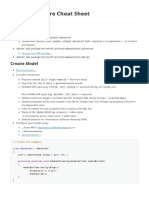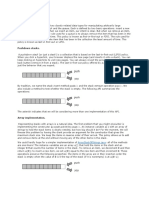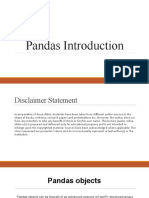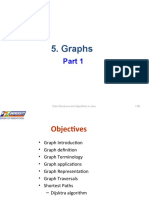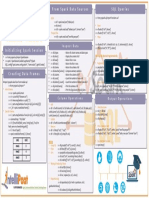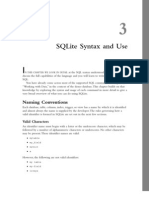List Data Structure: Data Structures and Algorithms in Java 1/23
List Data Structure: Data Structures and Algorithms in Java 1/23
Uploaded by
Lê Trần Đức ThịnhCopyright:
Available Formats
List Data Structure: Data Structures and Algorithms in Java 1/23
List Data Structure: Data Structures and Algorithms in Java 1/23
Uploaded by
Lê Trần Đức ThịnhOriginal Title
Copyright
Available Formats
Share this document
Did you find this document useful?
Is this content inappropriate?
Copyright:
Available Formats
List Data Structure: Data Structures and Algorithms in Java 1/23
List Data Structure: Data Structures and Algorithms in Java 1/23
Uploaded by
Lê Trần Đức ThịnhCopyright:
Available Formats
1.
List Data Structure
Data Structures and Algorithms in Java 1/23
Objectives
2
• Describe List structures
• Describe self-referential structures
• Explain types of linked lists
• Singly Linked Lists
• Circular Lists
• Doubly Linked Lists
• Lists in java.util
Data Structures and Algorithms in Java 2/23
List Data Structures
• A list is a sequential data structure, i.e. it is a sequence of items of a given
base type, where items can be added, deleted, and retrieved from any
position in the list.
• A list can be implemented as an array, or as a dynamic array to avoid
imposing a maximum size.
• An alternative implementation is a linked list, where the items are stored
in nodes that are linked together with pointers. These two
implementations have very different characteristics.
• The possible values of this type are sequences of items of type BaseType
(including the sequence of length zero). The operations of the ADT are:
getFirst(), getLast(), getNext(p), getPrev(p), get(p),
set(p,x), insert(p,x), remove(p),removeFirst(),
removeLast(), removeNext(p), removePrev(p),
find(x),size()
Data Structures and Algorithms in Java 3/23
Drawbacks of Arrays
4
• Array is a very useful data structure in many
situations. However, it has some important
limitations:
– They require size information for creation
– Inserting an element in the middle of an array leads to moving
other elements around
– Deleting an element from the middle of an array leads to moving
other elements around
• Other data structures are more efficient in such
situations.
Data Structures and Algorithms in Java 4/23
Self-Referential Structures
Many dynamic data structures are implemented through the use of a self-
referential structure.
A self-referential structure is an object, one of whose elements is a
reference to another object of its own type.
With this arrangement, it is possible to create ‘chains’ of data of varying
forms:
Self-Referential Structures
Data Structures and Algorithms in Java 5/23
Self-Referential Structures
Employee
String name;
int age;
Linked lists trees
DataNode DataNode
Employee info; Employee info;
DataNode next; DataNode left;
DataNode right;
Self-Referential Structures
10/14/21 Data Structures and Algorithms in Java 6/23
Linked Lists
7
• A linked structure is a collection of nodes storing data
and links to other nodes
• A linked list is a linear data structure composed of nodes,
each node holding some information and a reference to
another node in the list
• Types of linked lists:
– Singly-Linked List
– Doubly-Linked List
In programming, linear means that they are described by one (single) series of data … ie.
Each data item has at most one predecessor and at most one successor.
And, Non-linear means anything else.
Linear are – Array, Linked List, Stack, Queue. Non Linear are – Tree, Graph
Data Structures and Algorithms in Java 7/23
Singly Linked Lists
8
A singly linked list is a list whose node includes two
datafields: info and next. The info field is used to store
information, and this is important to the user. The next
field is used to link to its successor in this sequence
The following image depicts a simple integer linked list.
head tail
Singly Linked List
Data Structures and Algorithms in Java 8/23
Singly Linked List Implementation
9
class Node class MyList void add(int x)
{int info; {Node head,tail; { if(isEmpty())
Node next; MyList() head=tail=new Node(x,null);
Node() {} {head=tail=null;} else
Node(int x, Node p) boolean isEmpty() {Node q =new Node(x,null);
{info=x;next=p; {return(head==null); tail.next=q; tail=q;
} } }
} void clear() }
{head=tail=null; void traverse()
} {Node p=head;
while(p!=null)
{System.out.print(" " + p.info);
p=p.next;
}
System.out.println();
}
Node search(int x) {...}
void dele(int x) {...}
}
Data Structures and Algorithms in Java 9/23
Singly Linked Lists - 1
10
Inserting a new node at the beginning of a list
Inserting a new node at the beginning of a Singly Linked List
Data Structures and Algorithms in Java 10/23
Singly Linked Lists - 2
11
Inserting a new node at the end of a list
Inserting a new node at the end of a Singly Linked List
Data Structures and Algorithms in Java 11/23
Singly Linked Lists - 3
12
Deleting a node from the beginning of a list
Deleting a node from the beginning of a Singly Linked List
Data Structures and Algorithms in Java 12/23
Singly Linked List - 4
13
Deleting element from the end of a list
Deleting a node from the end of a Singly Linked List
Data Structures and Algorithms in Java 13/23
Circular Lists - 1
14
• A circular list is when nodes form a ring: The
list is finite and each node has a successor
Circular SIngly Linked List
Data Structures and Algorithms in Java 14/23
Circular Lists - 2
15
Inserting nodes
Inserting nodes at the front of a circular singly linked list (a) and at its end (b)
Data Structures and Algorithms in Java 15/23
Circular List application
1.
16
Round-Robin Scheduling
One of the most important roles of an operating system is in managing the
many processes that are currently active on a computer, including the
scheduling of those processes on one or more central processing units
(CPUs). In order to support the responsiveness of an arbitrary number of
concurrent processes, most operating systems allow processes to effectively
share use of the CPUs, using some form of an algorithm known as round-robin
scheduling. A process is given a short turn to execute, known as a time slice,
but it is interrupted when the slice ends, even if its job is not yet complete.
Each active process is given its own time slice, taking turns in a cyclic order.
2. Using circular linked list to implement Round-Robin Scheduling
We can use circular linked list to implement Round-Robin Scheduling by the
following method: rotate( ): Moves the first element to the end of the list.
With this new operation, round-robin scheduling can be efficiently
implemented by repeatedly performing the following steps on a circularly
linked list C:
1. Give a time slice to process C.first( )
2. C.rotate( )
Data Structures and Algorithms in Java 16/23
Doubly Linked Lists - 1
• In a doubly linked list, each
17
node has two reference class MyList
fields, one to the successor {Node head,tail;
and one to the predecessor MyList() {head=tail=null;}
boolean isEmpty()
{return(head==null); }
void clear() {head=tail=null;}
void add(int x)
{if(isEmpty())
Doubly Linked List head=tail=new Node(x,null,null);
class Node else
{int info; {Node q =new Node(x,tail,null);
Node prev,next; tail.next=q;
Node() {} tail=q;
Node(int x, Node p, Node q) }
{info=x;prev=p; next=q; }
} ...
} }
Data Structures and Algorithms in Java 17/23
Doubly Linked Lists - 2
18
Adding a new node at the end
Adding new node at the end of Doubly Linked List
Data Structures and Algorithms in Java 18/23
Doubly Linked Lists -3
19
Deleting a node from the end
Deleting a node from the end of Doubly Linked List
Data Structures and Algorithms in Java 19/23
Lists in java.util - LinkedList class
boolean add(E o) Appends the specified element to the end of this list.
void addFirst(E o) Inserts the given element at the beginning of this list.
void addLast(E o) Appends the given element to the end of this list.
void clear() Removes all of the elements from this list.
E get(int index) Returns the element at the specified position in this list.
E getFirst() Returns the first element in this list.
E getLast() Returns the last element in this list.
E remove(int index) Removes the element at the specified position in
this list.
E removeFirst()Removes and returns the first element from this list.
E removeLast() Removes and returns the last element from this list.
int size() Returns the number of elements in this list.
Object[] toArray() Returns an array containing all of the elements in this list in
the correct order.
Data Structures and Algorithms in Java 20/23
Lists in java.util
LinkedList class example
import java.util.*;
class Node
{ String name;
int age; class Main
Node() {} {
Node(String name1, int age1) public static void main(String [] args)
{ name=name1; age=age1; {
} LinkedList t = new LinkedList();
void set(String name1, int age1) Node x; int n,i;
{ name=name1; age=age1; x = new Node("A01",25); t.add(x);
} x = new Node("A02",23); t.add(x);
public String toString() x = new Node("A03",21); t.add(x);
{ String s = name+" "+age; for(i=0;i<t.size();i++)
return(s); System.out.println(t.get(i));
} }
} }
Data Structures and Algorithms in Java 21/23
Lists in java.util - ArrayList class
boolean add(E o) Appends the specified element to the end of this list.
void add(int index, E o) Inserts the given element at the specified pos.
void clear() Removes all of the elements from this list.
E get(int index) Returns the element at the specified position in this list.
E remove(int index) Removes the element at the specified position in this
list.
int size() Returns the number of elements in this list.
void ensureCapacity(int minCapacity) Increases the capacity of this ArrayList
instance, if necessary, to ensure that it can hold at least the number of elements
specified by the minimum capacity argument.
void trimToSize() Trims the capacity of this ArrayList instance to be the list's
current size.
Object[] toArray() Returns an array containing all of the elements in this list in the
correct order.
Data Structures and Algorithms in Java 22/23
Summary
• A list is a sequential data structure, i.e. it is a
sequence of items of a given base type.
• A list can be implemented as an array, or as a dynamic
array to avoid imposing a maximum size.
• An alternative implementation is a linked list , where
the items are stored in nodes that are linked together
with pointers.
• A singly linked list is when a node has a link to its
successor (next node) only.
• A circular list is when nodes form a ring: The list is
finite and each node has a successor.
• A doubly linked list is when a node has links to its
previous and to the next nodes.
Data Structures and Algorithms in Java 23/23
Reading at home
Text book: Data Structures and Algorithms in Java
• 3 Fundamental Data Structures 103
• 3.1 Using Arrays - . 104
• 3.2 Singly Linked Lists - 122
• 3.3 Circularly Linked Lists - 128
• 3.4 Doubly Linked Lists - 132
Data Structures and Algorithms in Java 24/23
You might also like
- DevOps For Data Science (Alex K Gold) (Z-Library)Document274 pagesDevOps For Data Science (Alex K Gold) (Z-Library)WilderGZRdNo ratings yet
- (Feature Engineering) (Extended-Cheatsheet)Document9 pages(Feature Engineering) (Extended-Cheatsheet)Aufa Fahmi WidyatnaNo ratings yet
- Ef Aspnet Cheat SheetDocument4 pagesEf Aspnet Cheat Sheetrtfm plizNo ratings yet
- Django DocumentationDocument2 pagesDjango DocumentationAnjan MalusareNo ratings yet
- Linked List StudentDocument21 pagesLinked List StudentPrei CyyNo ratings yet
- Hash (4) Cuckoo HashingDocument15 pagesHash (4) Cuckoo HashingMahmoudghmNo ratings yet
- Java Collection FrameworkDocument24 pagesJava Collection FrameworkShoaib SiddNo ratings yet
- Stacks and QueueDocument17 pagesStacks and QueuemuralikonathamNo ratings yet
- CSC 221 DSA Queue Arrays - Linked List Implementation 10032023 055715pmDocument59 pagesCSC 221 DSA Queue Arrays - Linked List Implementation 10032023 055715pmKumail RazaNo ratings yet
- DS StacksDocument64 pagesDS StacksHamada ChoumanNo ratings yet
- Data StructureDocument81 pagesData StructureSohoo Abdul QayoomNo ratings yet
- HSSLiVE XII CS Chapter - 3 Data Structures Joy PDFDocument4 pagesHSSLiVE XII CS Chapter - 3 Data Structures Joy PDFExtra WorkNo ratings yet
- Lab # 04 (Data Structure and Algorithm)Document5 pagesLab # 04 (Data Structure and Algorithm)lucasNo ratings yet
- Java Data Structures Cheat SheetDocument3 pagesJava Data Structures Cheat Sheetstudy studioNo ratings yet
- Natural Language Toolkit NLTK PDFDocument23 pagesNatural Language Toolkit NLTK PDFSamNo ratings yet
- Linked List: Data Structure & AlgorithmsDocument42 pagesLinked List: Data Structure & Algorithmsapi-394738731No ratings yet
- Python With Data ScienceDocument102 pagesPython With Data ScienceIrfanstudymeterialsNo ratings yet
- TCS QuestionsDocument5 pagesTCS QuestionsFann KannNo ratings yet
- Collections in JavaDocument15 pagesCollections in JavaMamata swainNo ratings yet
- 06 Java - Lang PackageDocument14 pages06 Java - Lang PackageGaneshNo ratings yet
- Cleaning Dirty Data With Pandas & Python - DevelopIntelligence Blog PDFDocument8 pagesCleaning Dirty Data With Pandas & Python - DevelopIntelligence Blog PDFaravindcj3600No ratings yet
- SortingDocument39 pagesSortingmulte1230% (1)
- Arrays and StringsDocument56 pagesArrays and StringsAAsfawNo ratings yet
- Data Structure Interview C Program: Questions To Create A Copy of A Linked ListDocument11 pagesData Structure Interview C Program: Questions To Create A Copy of A Linked ListschintapNo ratings yet
- Python Programming - Introduction AllDocument44 pagesPython Programming - Introduction AllJEEVITHA ANo ratings yet
- Development of An Indian Legal Language Model (LLM) For Enhanced Legal Text Analysis and AssistanceDocument7 pagesDevelopment of An Indian Legal Language Model (LLM) For Enhanced Legal Text Analysis and Assistanceprajwal pNo ratings yet
- U1 NLP App SolvedDocument26 pagesU1 NLP App SolvedArunaNo ratings yet
- Java 2Document52 pagesJava 2mahendar chuphalNo ratings yet
- LinkedList, Jagged Array, List, and Enumeration in JavaDocument29 pagesLinkedList, Jagged Array, List, and Enumeration in JavaSophia SarteNo ratings yet
- ALX Data Analytics Program DescriptionDocument6 pagesALX Data Analytics Program DescriptionChaymae SahraouiNo ratings yet
- Codility - How To Get Ascender Element in A Array - Stack Overflow - HTMDocument38 pagesCodility - How To Get Ascender Element in A Array - Stack Overflow - HTMprasureshNo ratings yet
- DSA Sheet by Rohit NegiDocument38 pagesDSA Sheet by Rohit Negispareadd.23No ratings yet
- Tools Machine LearningDocument9 pagesTools Machine LearningMaria LavanyaNo ratings yet
- OppDocument9 pagesOppHaripriya SridharanNo ratings yet
- Python Interview Questions and AnswersDocument3 pagesPython Interview Questions and AnswersSreenivasulu reddyNo ratings yet
- Data Structure Questions BankDocument30 pagesData Structure Questions BankRj SahooNo ratings yet
- Exception? A Catch Block That Catches The Exception of Type System - Exception. You Can Also Omit TheDocument6 pagesException? A Catch Block That Catches The Exception of Type System - Exception. You Can Also Omit ThetmnkinNo ratings yet
- B+ Tree & B TreeDocument38 pagesB+ Tree & B TreeRamkaran JanduNo ratings yet
- AI AgentsDocument9 pagesAI AgentsNirmal Varghese Babu 2528No ratings yet
- Model With One-Word Context: 2vec 2vec 2vec 2vecDocument17 pagesModel With One-Word Context: 2vec 2vec 2vec 2vecJun Wang100% (1)
- Lec 08-10 Ch3 Pandas IntroDocument28 pagesLec 08-10 Ch3 Pandas IntroMAryam KhanNo ratings yet
- ArraysDocument39 pagesArrayskavya gowdaNo ratings yet
- Stack Vs QueueDocument1 pageStack Vs QueueSutanu MUKHERJEENo ratings yet
- Time ComplexityDocument34 pagesTime ComplexityYukti Satheesh100% (1)
- Unit 1 Ome752 Supply Chain ManagementDocument23 pagesUnit 1 Ome752 Supply Chain ManagementSilent BoyNo ratings yet
- Digital Search TreeDocument30 pagesDigital Search TreeGladysChyNo ratings yet
- SpringBoot Annotations 1724042947Document13 pagesSpringBoot Annotations 1724042947Dhananjay DeshmukhNo ratings yet
- Graph RAGDocument7 pagesGraph RAGs.a.abidiNo ratings yet
- The Cargo BookDocument484 pagesThe Cargo BookMinh Loc0% (1)
- Data Structure Interview Questions (2022) - JavatpointDocument22 pagesData Structure Interview Questions (2022) - JavatpointAkhila RNo ratings yet
- Data Structures For First YearDocument23 pagesData Structures For First YearrajanikanthNo ratings yet
- Introduction To Parallel ProgrammingDocument129 pagesIntroduction To Parallel Programmingনিবিড় অভ্রNo ratings yet
- Introduction To Parallel ComputingDocument34 pagesIntroduction To Parallel ComputingMuhammed İkbaL Gürbüz100% (1)
- Python RecordDocument35 pagesPython Recorddinesh170900No ratings yet
- (4th Year) Roadmap To Dream PlacementDocument1 page(4th Year) Roadmap To Dream PlacementashwinNo ratings yet
- Final Exam Question 171 CSI217Document2 pagesFinal Exam Question 171 CSI217Parvej ahmedNo ratings yet
- Mastering Python Design Patterns: Craft essential Python patterns by following core design principlesFrom EverandMastering Python Design Patterns: Craft essential Python patterns by following core design principlesNo ratings yet
- Relational Database Index Design and the Optimizers: DB2, Oracle, SQL Server, et al.From EverandRelational Database Index Design and the Optimizers: DB2, Oracle, SQL Server, et al.Rating: 5 out of 5 stars5/5 (1)
- Sorting: Data Structures and Algorithms in Java 1/43Document43 pagesSorting: Data Structures and Algorithms in Java 1/43Lê Trần Đức ThịnhNo ratings yet
- Text Processing: Data Structures and Algorithms in Java 1/47Document47 pagesText Processing: Data Structures and Algorithms in Java 1/47Lê Trần Đức ThịnhNo ratings yet
- Graphs: Data Structures and Algorithms in Java 1/36Document36 pagesGraphs: Data Structures and Algorithms in Java 1/36Lê Trần Đức ThịnhNo ratings yet
- Hashing: 1/40 Data Structures and Algorithms in JavaDocument42 pagesHashing: 1/40 Data Structures and Algorithms in JavaLê Trần Đức ThịnhNo ratings yet
- Data Structures and ALGORITHMS Using Java: Course IntroductionDocument14 pagesData Structures and ALGORITHMS Using Java: Course IntroductionLê Trần Đức ThịnhNo ratings yet
- HDD For Relational Database Management System: ConfidentialDocument6 pagesHDD For Relational Database Management System: Confidentialthebhas1954No ratings yet
- Nutanix Objects: No More Storage SilosDocument3 pagesNutanix Objects: No More Storage SilosCCIE DetectNo ratings yet
- Comic Website: Group 1 Names: Fikri HanifDocument32 pagesComic Website: Group 1 Names: Fikri HanifIvan FirdausNo ratings yet
- DH&DM Unit-1Document16 pagesDH&DM Unit-1ApiNo ratings yet
- Intranet Search EngineDocument31 pagesIntranet Search EngineTage NobinNo ratings yet
- Cheat Sheet: From Spark Data Sources SQL QueriesDocument1 pageCheat Sheet: From Spark Data Sources SQL Queriesanuja shindeNo ratings yet
- SnapLogic Integrator CertificationDocument2 pagesSnapLogic Integrator CertificationSreekanth DaravathNo ratings yet
- Difference Between CDB and PDB in Oracle 12c - LinkedInDocument3 pagesDifference Between CDB and PDB in Oracle 12c - LinkedInsundarmsNo ratings yet
- SybaseRays InterviewQuestions For Sybase Senior RoleDocument18 pagesSybaseRays InterviewQuestions For Sybase Senior RoleNeelkant SinghNo ratings yet
- OBIEE BMM Layer Design PrinciplesDocument2 pagesOBIEE BMM Layer Design PrinciplesAmar ShirkeNo ratings yet
- Data Warehousing: Understanding A Data WarehouseDocument4 pagesData Warehousing: Understanding A Data Warehouserohan kumarNo ratings yet
- Entity FrameworkDocument16 pagesEntity FrameworkPradyumna DhumalaraoNo ratings yet
- Oracle Database 19c - New Features For AdministratorsDocument8 pagesOracle Database 19c - New Features For AdministratorsvineetNo ratings yet
- Exacc x7 Ds 4126773Document16 pagesExacc x7 Ds 4126773Jetender SambyalNo ratings yet
- DB2DataMovement Db2dme953Document495 pagesDB2DataMovement Db2dme953Charles MoonNo ratings yet
- File Allocation MethodsDocument9 pagesFile Allocation MethodsmasumiNo ratings yet
- Introduction-to-Database-and-SQL-Week 03-Fall-2022Document14 pagesIntroduction-to-Database-and-SQL-Week 03-Fall-2022Shivam PatelNo ratings yet
- Mysql Lab1Document2 pagesMysql Lab1Motaz IbrahimNo ratings yet
- Teradata ArchitectureDocument89 pagesTeradata ArchitecturelogeshwaranNo ratings yet
- Sqlite Syntax and Use: Naming ConventionsDocument30 pagesSqlite Syntax and Use: Naming ConventionsKevin NguyenNo ratings yet
- Backup Monitoring FormDocument3 pagesBackup Monitoring FormAlex BaldricNo ratings yet
- Advanced SQL Interview Questions and AnswersDocument5 pagesAdvanced SQL Interview Questions and Answersvara421No ratings yet
- Putaway Strategies:: " " - Manual Stock PlacementDocument2 pagesPutaway Strategies:: " " - Manual Stock PlacementsukmahiNo ratings yet
- Top 50 Hibernate Interview Questions & AnswersDocument7 pagesTop 50 Hibernate Interview Questions & AnswersDeeNo ratings yet
- QB With AnswersDocument12 pagesQB With AnswersThenmozhi RajagopalNo ratings yet
- Unit 9 Fundamentals of DatabaseDocument28 pagesUnit 9 Fundamentals of Databasevc78it10No ratings yet
- TS0149 Backing Up and Restoring BioStar 2's Database FAQDocument7 pagesTS0149 Backing Up and Restoring BioStar 2's Database FAQHEHHNo ratings yet
- The Database Environment: Modern Database Management 8 EditionDocument213 pagesThe Database Environment: Modern Database Management 8 EditionaaronNo ratings yet
- Teste SQLDocument77 pagesTeste SQLCăprariuCălinNo ratings yet


